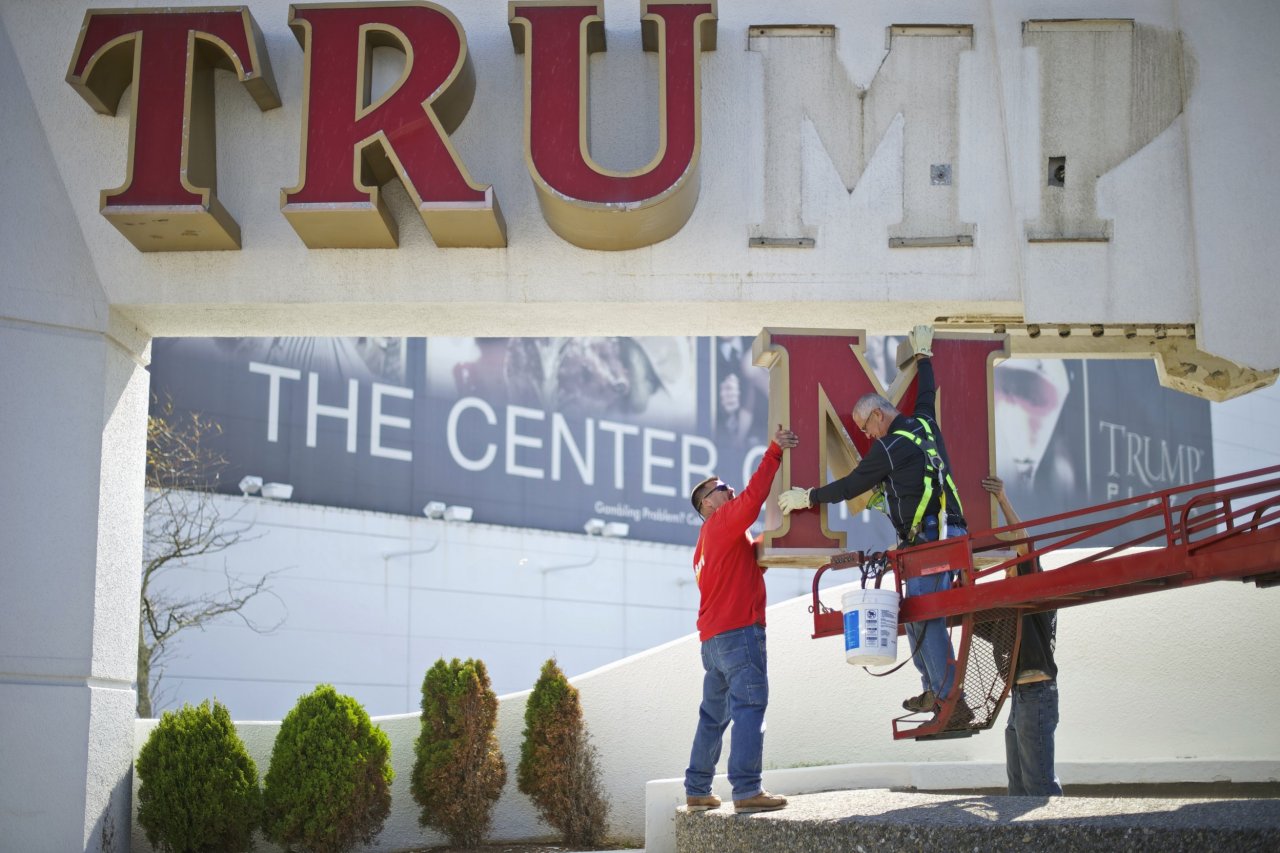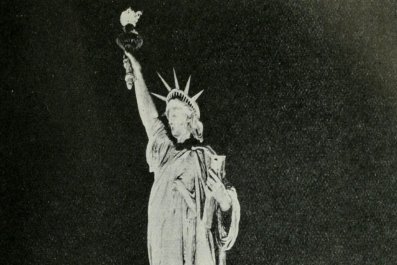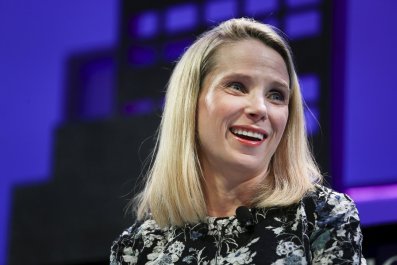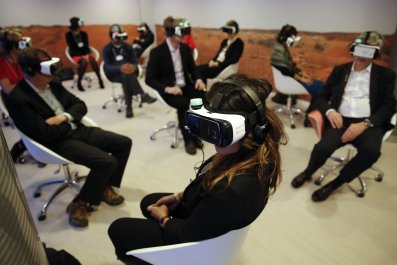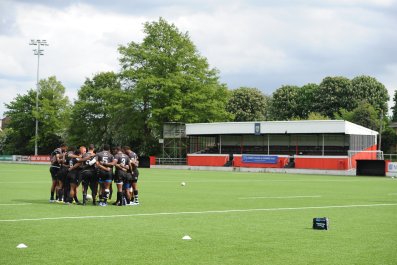Updated | Donald Trump was thundering about a minority group, linking its members to murderers and what he predicted would be an epic crime wave in America. His opponents raged in response—some slamming him as a racist—but Trump dismissed them as blind, ignorant of the real world.
No, this is not a scene from a recent rally in which the Republican nominee for president stoked fears of violence from immigrants or Muslims. The year was 1993, and his target was Native Americans, particularly those running casinos who, Trump was telling a congressional hearing, were sucking up to criminals.
Trump, who at the time was a major casino operator, appeared before a panel on Indian gaming with a prepared statement that was level-headed and raised regulatory concerns in a mature way. But, in his opening words, Trump announced that his written speech was boring, so he went off-script, even questioning the heritage of some Native American casino operators, saying they "don't look like Indians" and launching into a tirade about "rampant" criminal activities on reservations.
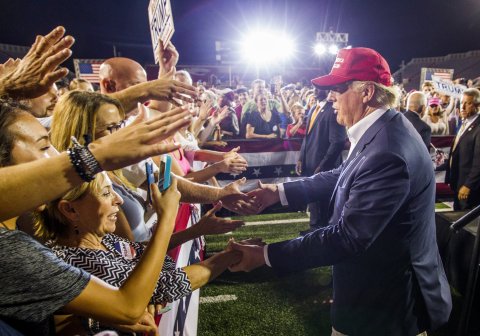
"If [Indian gaming] continues as a threat, it is my opinion that it will blow. It will blow sky high. It will be the biggest scandal ever or one of the biggest scandals since Al Capone," Trump said. "That an Indian chief is going to tell [mobster] Joey Killer to please get off his reservation is almost unbelievable to me."
His words were, as is so often the case, incendiary. Lawmakers, latching onto his claim to know more than law enforcement about ongoing criminal activity at Indian casinos, challenged Trump to bring his information to the FBI. One attacked Trump's argument as the most "irresponsible testimony" he had ever heard. Connecticut Governor Lowell Weicker Jr., whom Trump had praised in his testimony, responded by calling him a "dirtbag" and a bigot; Trump immediately changed his mind about the governor, proclaiming Weicker to be a "fat slob who couldn't get elected dog catcher in Connecticut."
For opponents of Trump's presidential run, this contretemps about American Indians might seem like a distant but familiar echo of the racism charges that have dogged his campaign, including his repeated taunting of Senator Elizabeth Warren as "Pocahontas" because she claims native ancestry. But, in this case, there was more to it than that: Trump, through his offensive tantrum, was throwing away financial opportunities, yet another reminder that, for all his boasting of his acumen and flaunting of his wealth, the self-proclaimed billionaire has often been a lousy businessman.
As Trump was denigrating Native Americans before Congress, other casino magnates were striking management agreements with them. Trump knew the business was there even when he was testifying; despite denying under oath that he had ever tried to arrange deals with Indian casinos, he had done just that a few months earlier, according to an affidavit from Richard Milanovich, the official from the Agua Caliente Band of Cahuilla Indians who met with Trump, letters from the Trump Organization and phone records. The deal for the Agua Caliente casino instead went to Caesars World. (In 2000, Trump won a contract to manage the casino for the Twenty-Nine Palms Band of Mission Indians, but after Trump Hotels and Casino Resorts declared bankruptcy in 2004, the tribe paid Trump $6 million to go away.) And in his purposeless, false and inflammatory statements before Congress, Trump alienated politicians from around the country, including some who had the power to influence construction contracts—problems that could have been avoided if he had simply read his prepared speech rather than ad-libbing.
Lost contracts, bankruptcies, defaults, deceptions and indifference to investors—Trump's business career is a long, long list of such troubles, according to regulatory, corporate and court records, as well as sworn testimony and government investigative reports. Call it the art of the bad deal, one created by the arrogance and recklessness of a businessman whose main talent is self-promotion.
He is also pretty good at self-deception, and plain old deception. Trump is willing to claim success even when it is not there, according to his own statements. "I'm just telling you, you wouldn't say that you're failing," he said in a 2007 deposition when asked to explain why he would give an upbeat assessment of his business even if it was in trouble. "If somebody said, 'How you doing?' you're going to say you're doing good." Perhaps such dissembling is fine in polite cocktail party conversation, but in the business world it's called lying.
And while Trump is quick to boast that his purported billions prove his business acumen, his net worth is almost unknowable given the loose standards and numerous outright misrepresentations he has made over the years. In that 2007 deposition, Trump said he based estimates of his net worth at times on "psychology" and "my own feelings." But those feelings are often wrong—in 2004, he presented unaudited financials to Deutsche Bank while seeking a loan, claiming he was worth $3.5 billion. The bank concluded Trump was, to say the least, puffing; it put his net worth at $788 million, records show. (Trump personally guaranteed $40 million of the loan to his company, so Deutsche coughed up the money. He later defaulted on that commitment.)
Trump's many misrepresentations of his successes and his failures matter—a lot. As a man who has never held so much as a city council seat, there is little voters can examine to determine if he is competent to hold office. He has no voting record and presents few details about specific policies. Instead, he sells himself as qualified to run the country because he is a businessman who knows how to get things done, and his financial dealings are the only part of his background available to assess his competence to lead the country. And while Trump has had a few successes in business, most of his ventures have been disasters.
Dependent on Daddy
When he was ready for college, Trump wanted to be a movie producer, perhaps the first sign that he was far more interested in the glitz of business than the nuts and bolts. He applied to the University of Southern California to pursue a film career, but when that didn't work out, he attended Fordham University; two years later, he transferred to the Wharton School of Business at the University of Pennsylvania and got a degree in economics.
Trump boasted when he announced his candidacy last year that he had made his money "the old-fashioned way," but he is no Bill Gates or Michael Bloomberg, self-made billionaires who were mavericks, innovators in their fields. Instead, the Republican nominee's wealth is Daddy-made. Almost all of his best-known successes are attributable to family ties or money given to him by his father.
The son of wealthy developer Fred Trump, he went to work for his father's real estate business immediately after graduating from Wharton and found some success by taking advantage of his father's riches and close ties to the power brokers in the New York Democratic Party, particularly his decades-long friend Abe Beame, the former mayor of the city.

Even with those advantages, a few of Trump's initial deals for his father were busts, based on the profits. His first project was revitalizing the Swifton Village apartment complex in Cincinnati, which his father had purchased for $5.7 million in 1962. After Trump finished his work, they sold the complex for $6.75 million, which, while appearing to be a small return, was a loss; in constant dollars, the apartment buildings would have had to sell for $7.9 million to have earned an actual profit. Still, Trump happily boasted about his supposed success with Swifton Village and about his surging personal wealth.
He already ached to be part of the Manhattan elite rather than just be known as the son of a Brooklyn developer. So, in 1970, he took another shot at joining the entertainment business by investing $70,000, to snag a co-producer's credit for a Broadway comedy called Paris Is Out! Once again, Trump failed; the play bombed, closing after just 96 performances.
The next year, he moved to Manhattan from the outer boroughs, still largely dependent on Daddy. In 1972, Trump's father brought him into a limited partnership that developed and owned a senior citizen apartment complex in East Orange, New Jersey. Fred Trump owned 75 percent, but two years later shrunk his ownership to 27 percent by turning over the rest of his stake to two entities controlled by his son. Another two years passed, and then Fred Trump named him the beneficiary of a $1 million trust that provided him with $1.3 million in income (2015 dollars) over the next five years. In 1978, he boosted his son's fortunes again, hiring him as a consultant to help sell his ownership interest in a real estate partnership to the Grandcor Company and Port Electric Supply Corp. The deal was enormously lucrative for Donald Trump, particularly since it just fell into his lap thanks to his family. Under the deal, Grandcor agreed to pay him an additional $190,000, while Port Electric kicked in $228,500. (The payments were made over several years, but the value in present-day dollars on the final sum he received is $10.4 million.)
Despite having no real success of his own, by the late 1970s, Trump was swaggering through Manhattan, gaining a reputation as a crass self-promoter. He hung out in the fancy nightspot Le Club, where he was chums with prominent New Yorkers like Roy Cohn, the one-time aide to Senator Joe McCarthy who was one of the city's most feared and politically connected attorneys. Cohn became one of the developer's lifelong mentors, encouraging the pugilistic personality that showed itself all the way back in second grade, when Trump punched his music teacher.
Soon Trump gained the public recognition he craved. Through a wholly owned corporation called Wembly Realty, Trump struck a partnership with a subsidiary of Hyatt Hotels. That partnership, Regency Lexington, purchased the struggling Commodore Hotel for redevelopment into the Grand Hyatt New York, a deal Trump crowed about when he announced he was running for president.
He failed to mention that this deal was once again largely attributable to Daddy, who co-guaranteed with Hyatt a construction loan for $70 million and arranged a credit line for his boy with Chase Manhattan Bank. The credit line was a favor to the Trump family, which had brought huge profits to the bank; according to regulatory records, the revolving loan was set up without even requiring a written agreement. Topping off the freebies and special deals that flowed Trump's way, the city tossed in a 40-year tax abatement. Trump's "success" with the Hyatt was simply the result of money from his dad, his dad's bank, Hyatt and the taxpayers of New York City.
Despite the outward signs of success, Trump's personal finances were a disaster. In 1978, the year his father set up that sweet credit line at Chase, Donald's tax returns showed personal losses of $406,386—$1.5 million in present-day dollars. Things grew worse in 1979, when he reported an income of negative $3.4 million, $11.2 million in constant dollars. All of this traced back to big losses in three real estate partnerships and interest he owed Chase. With Trump sucking wind and rapidly drawing down his line of credit, he turned again to Daddy, who in 1980 agreed to lend him $7.5 million.
All of these names and numbers can grow confusing for voters with little exposure to the business world. So to sum it all up, Trump is rich because he was born rich—and without his father repeatedly bailing him out, he would have likely filed for personal bankruptcy before he was 35.
Rolling Snake Eyes
As his personal finances were falling apart, Trump got a big idea for how to make money: casinos.
In early 1980, he received a phone call from Alan Lapidus, an architect who was a friend of Fred Trump. Lapidus gave Donald Trump a hot tip—there was a parcel of land available in Atlantic City that was zoned for use by a casino hotel. Gaming had been legalized in New Jersey in 1978, and casinos in Atlantic City were already reporting big business. At the time, Trump was deep into plans to turn Bonwit Teller's flagship department store into Trump Tower—a transformation achieved with the help of Roy Cohn, who fought in the courts to win Trump a huge tax abatement. Still, Trump jumped on the casino idea and had a lawyer reach out to the owners to negotiate a lease deal.
In August 1980, the Trump Plaza Corporation was incorporated in New Jersey, and nine months later it applied for a casino license. Trump wanted to build a 39-story, 612-room hotel and casino, but the banks refused to finance his adventure. So, instead, he struck a partnership with Harrah's Entertainment in which the global gaming company and subsidiary of Holiday Inn Inc. put up all the money in exchange for Trump developing the property. In 1984, Harrah's at Trump Plaza opened, and Trump seethed. He had wanted his name to be the marquee brand, even though Harrah's had an international reputation in casinos and he had none. He even delayed building a garage because his name was not being used prominently enough in the marketing.
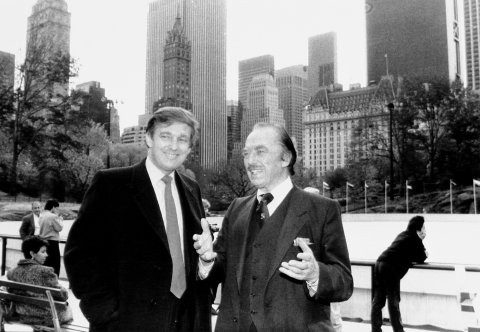
According to court papers, Harrah's spent $9.3 million promoting the Trump name, giving the New York developer a reputation in the casino business he'd never had before. And Harrah's quickly learned the price—now, with Trump able to argue he knew casinos, financing opportunities that did not exist before opened up, and he was able to use Harrah's promotion of him as a lever against the entertainment company. Soon after that first casino opened, Trump took advantage of his new credibility with financial backers interested in the gaming business to purchase the nearly completed Hilton Atlantic City Hotel for just $320 million; he renamed it Trump Castle. The business plan was ludicrous: Trump had not only doubled down his bet on Atlantic City casinos but was now operating two businesses in direct competition with each other. When Trump Castle opened in 1985, Harrah's decided to ditch Trump and sold its interest in their joint venture to him for $220 million.
Still, he wanted more in Atlantic City—specifically, the Taj Mahal, the largest casino complex ever, which Resorts International was building. This made the Casino Control Commission nervous because it could have meant that the financial security of Atlantic City would be riding on the back of one man. But Trump brushed those concerns aside at a February 1988 licensing hearing—after all, his argument went, he was Donald Trump. He would contain costs, he said, because banks would be practically throwing money at him, and at prime rates. He would be on a solid financial foundation because the banks loved him so much, unlike lots of other companies and casinos that used below-investment-grade, high-interest junk bonds for their financing. "I'm talking about banking institutions, not these junk bonds, which are ridiculous," he testified.
But Trump's braggadocio proved empty. No financial institution gave him anything. Instead, he financed the deal with $675 million in junk bonds, agreeing to pay an astonishing 14 percent interest, about 50 percent more than he had projected. That pushed Trump's total debt for his three casinos to $1.2 billion. For the renamed Trump Taj Mahal to break even, it would have to pull in as much as $1.3 million a day in revenue, more than any casino ever.
Disaster hit fast. As had been predicted by some Wall Street analysts, Trump's voracious appetite cannibalized his other casinos—it was as if Trump had tipped the Atlantic City boardwalk and slid all his customers at the Trump Castle and Trump Plaza down to the Taj. Revenues for the two smaller casinos plummeted a combined $58 million that first year.
Meanwhile, another Trump disaster was brewing. Eastern Air Lines, which had been struggling, put its northeastern air shuttle up for sale. Trump persuaded the banks to lend him $380 million to purchase the route, and in June 1989 the Trump Shuttle began flying.
Trump introduced the airline with his usual style—by insulting the competition. At an elegant event at Logan Airport in Boston, Trump took the stage and suggested that the other airline with a northeastern shuttle, Pan Am, flew unsafe planes. Pan Am didn't have enough cash, he said, and so it couldn't spend as much as the Trump Shuttle on maintenance. "I'm not criticizing Pan Am," Trump told the assembled crowd. "I'm just speaking facts." But Trump offered no proof, and others in the airline industry seethed; talking about possible crashes was bad for everyone's business.
He promised to transform his shuttle into a luxury service—bathroom fixtures were colored gold, and the plane interiors were decked out with mahogany veneer. He was spending $1 million to update each of the planes, which were individually worth only $4 million. With those changes, he boasted, he would increase the shuttle's market share from 55 to 75 percent.
But just like with casinos, Trump was in a business he knew nothing about. Customers on a one-hour flight from Washington to New York didn't want luxury; they wanted reliability and competitive prices.
Trump Shuttle never turned a profit. But it didn't have much of a chance; even as he was preening about his successes, Trump's businesses were falling apart and would soon bring the shuttle crashing down with them.
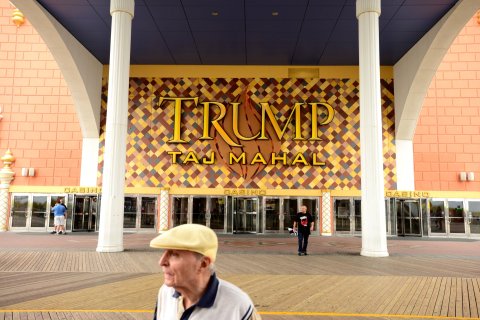
Bragging About How Much He Owes
At 1:40 p.m. on October 10, 1989, the four-blade rotor and tail rotor broke off of a helicopter flying above the pine woodlands near Forked River, New Jersey. The craft plunged 2,800 feet to the ground, killing all five passengers. Among them were three of Trump's top casino executives.
With the best managers of his casinos dead, Trump for the first time took responsibility for running the day-to-day operations in Atlantic City. His mercurial and belligerent style made a quick impact—some top executives walked, unwilling to put up with his eccentricities, while Trump booted others. The casinos were struggling so badly that Trump was sweating whether a few big winners might pull him under. He once hovered over a baccarat table at the Plaza, anxiously watching a Tokyo real estate tycoon who had won big at the casino in the past; executives at the casino were humiliated, since Trump was signaling that he was frightened customers might win. (The Japanese tycoon lost that night.) By early 1990, as financial prospects at the casinos worsened, Trump began badmouthing the executives who had died, laying blame on them, although the cause of his problems was the precarious, debt-laden business structure he had built.
By June 1990, Trump was on the verge of missing a $43 million interest payment to the investors in the Taj's junk bonds. Facing ruin, he met with his bankers, who had almost no recourse—they had been as reckless as Trump. By lending him billions—with loans for his real estate, his casinos, his airline and other businesses—they could fail if Trump went down. So the banks agreed to lend him tens of millions more in exchange for Trump temporarily ceding control over his multibillion-dollar empire and accepting a budget of $450,000 a month for personal expenditures. In August, New Jersey regulators prepared a report totaling Trump's debt at $3.4 billion, writing that "a complete financial collapse of the Trump Organization was not out of the question."
In September, Trump informed his bankers that he would not be paying the $1.1 million in interest due and asked that they defer $245 million of future loan payments. Once again, the banks could do little but agree. The shuttle business was put up for sale, as was his $29 million yacht, the Trump Princess. (In 1992, Trump defaulted on his debt for the shuttle and turned it over to his creditor banks.)
By December, Trump was on the verge of missing an interest payment on the debt of Trump Castle, and there was no room left to maneuver with the banks this time. So, just as he had in the past, Trump turned to Dad for help, according to New Jersey state regulatory records. On December 17, 1990, Fred Trump handed a certified check for $3.35 million payable to the Trump Castle to his attorney, Howard Snyder. Snyder traveled to the Castle and opened an account in the name of Fred Trump. The check was deposited into that account and a blackjack dealer paid out $3.35 million to Snyder in gray $5,000 chips. Snyder put the chips in a small case and left; no gambling took place. The next day, a similar "loan" was made—except by wire transfer rather than by check—for an additional $150,000. This surreptitious, and unreported, loan allowed Donald Trump to make that interest payment. (The Castle later settled charges by the Casino Control Commission of violations from this escapade and paid a $65,000 fine.)
It didn't matter—Trump's casino empire was doomed. A little more than a year after the opening of the Taj, that casino was in bankruptcy court, and was soon followed there by the Plaza and the Castle. Under the reorganization, Trump turned over half his interest in the businesses in exchange for lower rates of interest, as well as a deferral of payments and an agreement to wait at least five years before pursuing Trump for the personal guarantees he had made on some of the debt. The total debt remained huge, weighing down the reorganized company for years. In 2004, Trump Hotels & Casino Resorts—the new name for Trump's casino holdings—filed for bankruptcy, and Trump was forced to relinquish his post as chief executive. The name of the company was then changed to Trump Entertainment Resorts; it filed for bankruptcy in 2009, four days after Trump resigned from the board.
In his books and public statements, Trump holds up this bankruptcy as yet more proof of his business genius; after all, his logic goes, he climbed out of a hole so deep few others could have done it. He even brags now about how deep that hole was. Trump falsely claimed in two of his books that he owed $9.2 billion, rather than the actual number, $3.4 billion, making his recovery seem far more impressive. (When challenged on the misrepresentation during a 2007 deposition, Trump blamed the error on Meredith McIver, a longtime employee who helped write that book. Trump testified that he recognized the mistake shortly after the first book mentioning it was published; he never explained why he allowed it to appear again in the paperback edition and even in his next book. McIver went on to garner some national recognition as a Trump scapegoat—nine years later, when Trump's wife, Melania, delivered a speech at the Republican National Convention that was partially plagiarized from Michelle Obama, the campaign blamed McIver. But despite all this supposed sloppiness, Trump has never directed his trademark phrase "You're fired!" at this loyal employee.)
Rich in Name Only
Huge corporate failures are the stuff of headlines, but Trump's mistakes in business have included plenty of small deals as well. In 2008, he defaulted on a $640 million construction loan for Trump International Hotel & Tower in Chicago, and the primary lender, Deutsche Bank, sued him. Trump countersued, howling that the bank had damaged his reputation. In a snarky court reply, Deutsche Bank said, "Trump is no stranger to overdue debt." (The suit was ultimately resolved, with Deutsche Bank extending the terms of the loan; another lender, Fortress Investment Group, had to suck up losses from its foray into Trump's Chicago project.)
Trump has also based huge projects on temporary business trends. For example, for a few years during the George W. Bush administration, wealthy expatriates from around the Middle East flocked to Dubai. In response, Trump launched work on a 62-story luxury hotel and apartment complex on an artificial island shaped like a palm tree. But, as was predictable from the start, there were only so many rich people willing to travel to the United Arab Emirates, so the flood of wealthy foreigners into the country slowed. The Trump Organization was forced to walk away from the project, flushing its investments in it.
Beginning in 2006, Trump decided to take a new direction and basically cut back on building in favor of selling his name. This led to what might be called his nonsense deals, with Trump slapping his name on everything but the sidewalk, hoping people would buy products just because of his brand.
Trump hosted a glitzy event in 2006 touting Trump Mortgage, then proclaimed he had nothing to do with managing the firm when it collapsed 18 months later. (Trump tried again, rechristening the failed entity as Trump Financial. It also failed.) That same year, he opened GoTrump.com, an online travel service that never amounted to more than a vanity site; the URL now sends searchers straight to the Trump campaign website. Also in 2006, Trump unveiled Trump Vodka, predicting that the T&T (Trump and Tonic) would become the most requested drink in America (he also marketed it to his friends in Russia, land of some of the world's greatest vodkas); within a few years, the company closed because of poor sales. In 2007, Trump Steaks arrived. After two months of being primarily available for sale at Sharper Image, that endeavor ended; the head of Sharper Image said barely any of the steaks sold.
Amusing as those fiascos are for those of us who didn't lose money on them, the most painful debacles to witness were many involving licensing agreements Trump sold to people in fields related to real estate. There is the now-infamous Trump University, where students who paid hefty fees were supposed to learn how to make fortunes in that industry by being trained by experts handpicked by Trump; many students have sued, saying the enterprise was a scam in which Trump allowed his name to be used but had nothing else to do with it, despite his claims to the contrary in the marketing for the "school." The litigation has already revealed plenty of evidence that the endeavor was a scam. Particularly damning was the testimony of former employee Ronald Schnackenberg, who recalled being chastised by Trump University officials for failing to push a near-destitute couple into paying $35,000 for classes by using their disability income and a home equity loan.
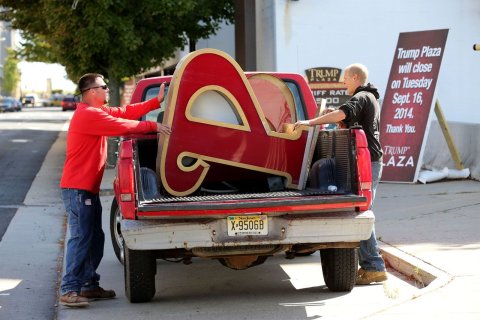
Around the country, buyers were led to believe they were purchasing apartments in buildings overseen by Trump, although his only involvement in many cases was getting paid for the use of his brand. For example, in 2009, Trump and a developer named Jorge Pérez unveiled plans for Trump Hollywood, a 40-story oceanfront condominium that they boasted would sell at premium prices and feature such luxuries as Italian cabinetry. But with the entire real estate market imploding, condo buyers were looking for bargains, and sales were minuscule. In 2010, lenders foreclosed on the $355 million project. Even though Trump's name was listed on the condominium's website as the developer, he immediately distanced himself from the project, saying he had only licensed his name.
A similarly sordid tale unfolded for Trump Ocean Resort Baja Mexico, a 525-unit luxury vacation home complex that Trump proclaimed was going to be "very, very special." His name and image were all over the property, and he even personally appeared in the marketing video discussing how investors would be "following" him if they bought into the building. Scores of buyers ponied up deposits in 2006, but by 2009 the project was still just a hole in the ground. That year, the developers notified condo buyers their $32 million in deposits had been spent, no bank financing could be obtained, and they were walking away from the project. Scores of lawsuits claimed the buyers were deceived into believing Trump was the developer. Trump walked away from the deal, saying that if the condo buyers had any questions, they needed to contact the developer—and that wasn't him, contrary to what the marketing material implied.
The same story has played out again and again. In Fort Lauderdale, Florida, people who thought they were buying into a Trump property lost their deposits of at least $100,000, with Trump saying it was not his responsibility because he had only licensed his name.
Investors in another failed Floridian property, Trump Tower Tampa, put up millions in the project in 2005 believing the building was being constructed by him. Instead, they discovered it was all a sham in 2007, inadvertently from Trump, when he sued the builder for failing to pay his license fees. The investors lost their money, and finally got to hear Trump respond to allegations that he had defrauded them when they sued him. In a deposition, lawyers for the Tampa buyers asked him if he would be responsible for any shoddy construction; Trump responded that he had "no liability" because it was only a name-licensing deal. As for the investors, some of whom surrendered their life savings for what they thought was a chance to live in a Trump property, Trump said they at least dodged the collapse of the real estate market by not buying the apartments earlier.
"They were better off losing their deposit," he said.
So said the man who now proclaims that Americans can trust him, that he cares only about their needs and their country, that he is on the side of the little guy.
Editor's Note: This article has been updated to reflect the correct location of Swifton Village, in Cincinnati, and not in the originally-stated location of Cleveland, Ohio.



